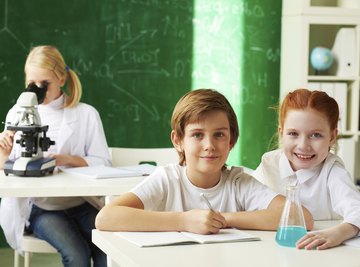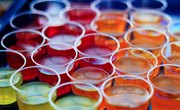
As a first-grade teacher, you can help your students understand basic principles about the properties of matter -- solid, liquid and gas -- by performing classroom experiments. Students should be able to visualize many of the differences and make their own inferences, such as that gases generally weigh less than solids and properties of matter can change by raising or lowering the temperature. Involve your students in hands-on discovery to increase their interest and understanding.
Ice, Water and Gas Balloons
Help your students explore differences in properties of matter through sight and touch. Before class, fill a small balloon with water and freeze it, fill another balloon with water but don't freeze it and fill a third balloon with air. Pass the balloons around the class and have your students take turns squeezing them softly. Ask them to explain what they see and feel. Introduce the terms "solid," "liquid" and "gas." Discuss features of the balloons, such as what would happen if you stuck a needle in each balloon or threw them at a wall. Students should learn different characteristics of the balloons, such as which one is the heaviest, most pliable or softest to squeeze.
Mystery Item Categorizing
Create a three-column chart on your blackboard or white board to help students understand property differences and categorize items accordingly. Label the columns "solid," "liquid" and "gas." Before class, put a small solid object, a small liquid container or a piece of paper with a gas-related term inside individual paper lunch sacks -- one sack for each student. For example, you might use an apple, a box of playing cards or a toy car for solids; a liquid glue tube, baby doll bottle or boxed juice drink are examples of liquids; and the words "air," "oxygen" and "helium" might work for gas. One at a time, ask students to open their sacks, reveal their item and explain why the item falls under a specific category. Write the item in the appropriate column. After all the sacks have been opened, ask your students to describe features in each column: For example, liquids are runny, gases are invisible and solids can be held in your hand.
Water Wonders With Ice
Illustrate how water exists in three states so first-graders understand that outside factors, such as temperature, affect properties of matter. You will need a microwave for this. Give each student a clear plastic cup containing an ice cube, and ask students to guess what will happen to it outside the freezer. Have students divide a piece of paper into three columns, labeled "solid," "liquid" and "gas." Have them draw a picture of the ice cube in the cup in the first column. Collect the melted ice water from each student's cup and put it in a microwave-safe cup. Ask students to draw a picture of the water in the cup in column two. Heat the water in the microwave to the boiling point and show students -- from a distance -- the resulting steam. Instruct them to draw a picture of the steam in the last column. Explain that water freezes to solid form at 32 degrees Fahrenheit and boils at 212 degrees, emitting water vapor.
Fizzy Gas Bubbles
Perform a classroom experiment to teach your first-graders how interactions between liquids and solids can produce gases. In front of your students, pour three tablespoons of vinegar and three tablespoons of water into a slender, clear bottle, such as a soft drink bottle. Use a funnel to fill a deflated balloon half full of baking soda. Introduce the term "hypothesis," and ask your students to guess what might happen when you attach the balloon to the bottle. Attach the balloon, allowing the baking soda to dump rapidly into the vinegar. Ask your students to examine the sounds and sights -- fizzy bubbles and a gas-inflated balloon.
References
About the Author
As curriculum developer and educator, Kristine Tucker has enjoyed the plethora of English assignments she's read (and graded!) over the years. Her experiences as vice-president of an energy consulting firm have given her the opportunity to explore business writing and HR. Tucker has a BA and holds Ohio teaching credentials.
Photo Credits
shironosov/iStock/Getty Images
